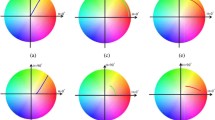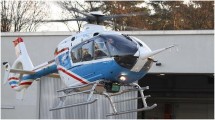Abstract
Cabin hatch cover plays an important role for a typical aircraft to ensure the aircraft quality and flight safety. In the test flight inspection and routine maintenance of an aircraft, one crucial step is to open cabin hatch covers one by one for detailed inspection. Authorized operators suffer from difficulties to recognize different covers with similar shapes and different inspection requirements. In this paper, an edge-based cover recognition and tracking method is proposed to recognize different hatch covers with similar shapes. First, a fast edge feature is proposed to describe image contours with simple geometric constraints. Second, based on the edge feature, a novel cover descriptor, consisting of shape and position description vectors, is presented to recognize those different covers with similar shapes. Third, on the basis of recognized cover landmarks, a direct visual odometry–based camera tracking method is presented to improve the robustness of cover recognition. The experiments are implemented in a piece of simplified mockup of aircraft cabin skin, and the results show that the proposed method has good practicability and real-time property. Meanwhile, the tracking accuracy is also good enough in the augmented reality inspection environment.












Similar content being viewed by others
References
Wang X, Ong SK, Nee AYC (2016) A comprehensive survey of augmented reality assembly research. Adv Manuf 4(1):1–22. https://doi.org/10.1007/s40436-015-0131-4
Zubizarreta J, Aguinaga I, Amundarain A (2019) A framework for augmented reality guidance in industry. Int J Adv Manuf Tech 102(9–12):4095–4108. https://doi.org/10.1007/s00170-019-03527-2
Fang HC, Ong SK, Nee AYC (2013) Orientation planning of robot end-effector using augmented reality. Int J Adv Manuf Tech 67(9–12):2033–2049. https://doi.org/10.1007/s00170-012-4629-7
Zhu J, Ong SK, Nee AYC (2013) An authorable context-aware augmented reality system to assist the maintenance technicians. Int J Adv Manuf Tech 66(9–12):1699–1714. https://doi.org/10.1007/s00170-012-4451-2
Wang Y, Zhang S, Yang S, He W, Bai X, Zeng Y (2016) A LINE-MOD-based markerless tracking approachfor AR applications. Int J Adv Manuf Tech 89(5–8):1699–1707. https://doi.org/10.1007/s00170-016-9180-5
Wang Y, Zhang SS, Wan BL, He WP, Bai XL (2018) Point cloud and visual feature-based tracking method for an augmented reality-aided mechanical assembly system. Int J Adv Manuf Tech 99(9–12):2341–2352. https://doi.org/10.1007/s00170-018-2575-8
Yin X, Fan X, Zhu W, Liu R (2019) Synchronous AR assembly assistance and monitoring system based on ego-centric vision. Assem Autom 39(1):1–16. https://doi.org/10.1108/aa-03-2017-032
Bruno F, Barbieri L, Marino E, Muzzupappa M, D’Oriano L, Colacino B (2019) An augmented reality tool to detect and annotate design variations in an Industry 4.0 approach. Int J Adv Manuf Tech 105(1–4):875–887. https://doi.org/10.1007/s00170-019-04254-4
Xia R, Zhao J, Zhang T, Su R, Chen Y, Fu S (2020) Detection method of manufacturing defects on aircraft surface based on fringe projection. Optik 208.https://doi.org/10.1016/j.ijleo.2020.164332
Wang X, Yew AWW, Ong SK, Nee AYC (2019) Enhancing smart shop floor management with ubiquitous augmented reality. Int J Prod Res 58:2352–2367. https://doi.org/10.1080/00207543.2019.1629667
Siew CY, Ong SK, Nee AYC (2019) A practical augmented reality-assisted maintenance system framework for adaptive user support. Robot Cim-Int Manuf 59:115–129. https://doi.org/10.1016/j.rcim.2019.03.010
Ong SK, Yew AWW, Thanigaivel NK, Nee AYC (2020) Augmented reality-assisted robot programming system for industrial applications. Robot Cim-Int Manuf 61:101820. https://doi.org/10.1016/j.rcim.2019.101820
Ong SK, Yuan ML, Nee AYC (2008) Augmented reality applications in manufacturing: a survey. Int J Prod Res 46(10):2707–2742. https://doi.org/10.1080/00207540601064773
Munoz E, Konishi Y, Murino V, Bue AD (2016) Fast 6D pose estimation for texture-less objects from a single RGB image. In: 2016 IEEE International Conference on Robotics and Automation (ICRA)
Lowe DG (2004) Distinctive image features from scale-invariant keypoints. Int J Comput Vision 60(2):91–110. https://doi.org/10.1023/B:Visi.0000029664.99615.94
Bay H, Ess A, Tuytelaars T, Van Gool L (2008) Speeded-Up Robust Features (SURF). Comput Vis Image Und 110(3):346–359. https://doi.org/10.1016/j.cviu.2007.09.014
Rublee E, Rabaud V, Konolige K, Bradski G (2011) ORB: an efficient alternative to SIFT or SURF. 2011 Ieee Int Conf Comput Vis (ICCV) 2564–2571. https://doi.org/10.1109/iccv.2011.6126544
Hinterstoisser S, Lepetit V, Ilic S, Fua P, Navab N (2010) Dominant orientation templates for real-time detection oftexture-less objects. IEEE Conf Comput Vis Pattern Recogn (CVPR) 23:2257–2264
Hinterstoisser S, Cagniart C, Ilic S, Sturm P, Navab N, Fua P, Lepetit V (2012) Gradient response maps for real-time detection of textureless objects. IEEE Trans Pattern Anal Mach Intell 34(5):876–888. https://doi.org/10.1109/TPAMI.2011.206
Hinterstoisser S, Lepetit V, Ilic S, Holzer S, Bradski G, Konolige K, Navab N (2013) Model based training, detection and pose estimation of texture-less 3D objects in heavily cluttered scenes. In: 2012 Asian Conference on Computer Vision, pp 548–562
Zhang H, Cao Q (2019) Detect in RGB, optimize in edge: accurate 6D pose estimation for texture-less industrial parts. In: Howard A, Althoefer K, Arai F et al. (eds) 2019 International Conference on Robotics and Automation. IEEE International Conference on Robotics and Automation ICRA, pp 3486–3492
Ulrich M, Wiedemann C, Steger C (2012) Combining scale-space and similarity-based aspect graphs for fast 3D object recognition. IEEE Trans Pattern Anal Mach Intell 34(10):1902–1914. https://doi.org/10.1109/tpami.2011.266
Joshi N, Sharma Y, Parkhiya P, Khawad R, Krishna KM, Bhowmick B (2018) Integrating objects into monocular SLAM: line based category specific models. Proceedings of the 11th Indian Conference on Computer Vision, Graphics and Image Processing. https://doi.org/10.1145/3293353.3293434
Yang S, Scherer S (2019) CubeSLAM: monocular 3-D object SLAM. IEEE Trans Robot 35(4):925–938. https://doi.org/10.1109/TRO.2019.2909168
Mur-Artal R, Montiel JMM, Tardos JD (2015) ORB-SLAM: a versatile and accurate monocular SLAM system. IEEE Trans Robot 31(5):1147–1163. https://doi.org/10.1109/Tro.2015.2463671
Mur-Artal R, Tardos JD (2017) ORB-SLAM2: an open-source SLAM system for monocular, stereo, and RGB-D cameras. IEEE Trans Robot 33(5):1255–1262. https://doi.org/10.1109/Tro.2017.2705103
Han P, Zhao G (2019) A review of edge-based 3D tracking of rigid objects. Virtual Real Intell Hardw 1(6):580–596. https://doi.org/10.1016/j.vrih.2019.10.001
Harris C, Stennett C (1990) RAPID - a video rate object tracker. In: British Machine Vision Conference, pp 73–77
Choi C, Christensen HI (2012) Robust 3D visual tracking using particle filtering on the special Euclidean group: a combined approach of keypoint and edge features. Int J Robot Res 31(4):498–519
Wang B, Zhong F, Qin X (2019) Robust edge-based 3D object tracking with direction-based pose validation. Multimed Tools Appl 78(9):12307–12331. https://doi.org/10.1007/s11042-018-6727-5
Trinh S, Spindler F, Marchand E, Chaumette F (2018) A modular framework for model-based visual tracking using edge, texture and depth features. In: 2018 IEEE International Conference on Intelligent Robots and Systems (IROS), pp 89–96. https://doi.org/10.1109/IROS.2018.8594003
Koller D, Daniilidis K, Nagel HH (1993) Model-based object tracking in monocular image sequences of road traffic scenes. Int J Comput Vis 10(3):257–281
Tombari F, Franchi A, Di Stefano L (2013) BOLD features to detect texture-less objects. Ieee I Conf Comp Vis:1265–1272. https://doi.org/10.1109/Iccv.2013.160
Yin X, Fan X, Yang X, Qiu S (2019) An image appearance based optimization scheme for monocular 6D pose estimation of SOR cabins. Optik 199:163115. https://doi.org/10.1016/j.ijleo.2019.163115
Canny J (1986) A computational approach to edge detection. IEEE Trans Pattern Anal Mach Intell 8(6):679–698
Douglas DH, Peucker TK (2011) Algorithms for the reduction of the number of points required to represent a digitized line or its caricature. Class Cartogr: Reflect influential Artic Cartogr 10:15–28. https://doi.org/10.1002/9780470669488.ch2
Lepetit V, Moreno-Noguer F, Fua P (2009) EPnP: an accurate O(n) solution to the PnP problem. Int J Comput Vis 81(2):155–166. https://doi.org/10.1007/s11263-008-0152-6
Newcombe RA, Lovegrove SJ, Davison AJ (2011) DTAM: dense tracking and mapping in real-time. 2011 Ieee International Conference on Computer Vision (Iccv), pp 2320–2327. https://doi.org/10.1109/iccv.2011.6126513
Forster C, Zhang ZC, Gassner M, Werlberger M, Scaramuzza D (2017) SVO: semidirect visual odometry for monocular and multicamera systems. IEEE Trans Robot 33(2):249–265. https://doi.org/10.1109/Tro.2016.2623335
Engel J, Koltun V, Cremers D (2018) Direct sparse odometry. IEEE Trans Pattern Anal Mach Intell 40(3):611–625. https://doi.org/10.1109/Tpami.2017.2658577
Sida P, Yuan L, Qixing H, Xiaowei Z, Hujun B (2019) PVNet: pixel-wise voting network for 6DoF pose estimation. 2019 IEEE/CVF Conference on Computer Vision and Pattern Recognition (CVPR) Proceedings, pp 4556–4565. https://doi.org/10.1109/cvpr.2019.00469
Romero-Ramirez FJ, Munoz-Salinas R, Medina-Carnicer R (2018) Speeded up detection of squared fiducial markers. Image Vis Comput 76:38–47. https://doi.org/10.1016/j.imavis.2018.05.004
Funding
This work was supported by the Chengdu Aircraft Industry (Group) Co. Ltd. of Aviation Industry Corporation of China (Grant No. 40113000050X).
Author information
Authors and Affiliations
Corresponding author
Additional information
Publisher’s note
Springer Nature remains neutral with regard to jurisdictional claims in published maps and institutional affiliations.
Rights and permissions
About this article
Cite this article
Yang, X., Fan, X., Wang, J. et al. Edge-based cover recognition and tracking method for an AR-aided aircraft inspection system. Int J Adv Manuf Technol 111, 3505–3518 (2020). https://doi.org/10.1007/s00170-020-06301-x
Received:
Accepted:
Published:
Issue Date:
DOI: https://doi.org/10.1007/s00170-020-06301-x




